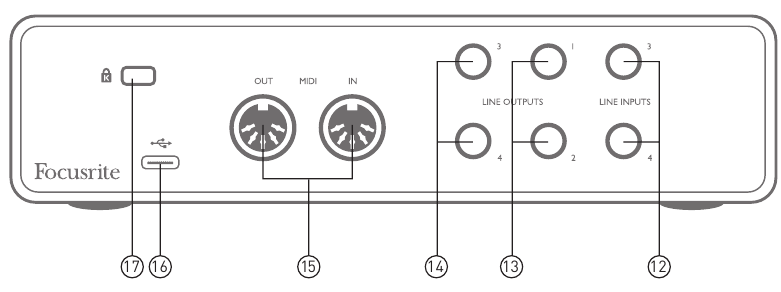OVERVIEW
Introduction
Thank you for purchasing this Third Generation Scarlett 4i4, one of the family of Focusrite professional computer audio interfaces incorporating high quality Focusrite analogue preamps. You now have a simple and compact solution for routing high quality audio to and from your computer and you will also be able to download some exciting new software plug-ins once you’ve registered the product.
In developing the Third Generation series of Scarlett interfaces, we have made further improvements to both performance and features. Audio specifications have been upgraded throughout the unit to give you greater dynamic range and even lower noise and distortion; additionally, the mic preamp now accepts higher input levels. An important enhancement is the inclusion of Focusrite’s AIR function. Individually selectable on Inputs 1 and 2, AIR subtly modifies the preamp’s frequency response to model the sonic characteristics of our classic transformer-based ISA microphone preamps. When recording with good quality microphones, you will notice an enhanced clarity and definition in the important mid to high frequency range, just where it is most needed for vocals and many acoustic instruments. Third Generation Scarlett interfaces are class compliant on macOS: this means they are plug-and-play, so no need to install a driver if you are a Mac user.
This User Guide provides a detailed explanation of the hardware to help you achieve a thorough understanding of the product’s operational features. We recommend that both users who are new to computer-based recording, as well as more experienced users, take the time to read through the User Guide so that you are fully aware of all the possibilities that the Scarlett 4i4 and accompanying software has to offer. If the main User Guide sections do not provide the information you need, be sure to consult https://support.focusrite.com/, which contains a comprehensive collection of answers to common technical support queries.
Features
The Scarlett 4i4 hardware interface provides the means for connecting microphones, musical instruments or line level audio signals to a computer running Mac OS or Windows. The signals at the physical inputs can be routed to your audio recording software / digital audio workstation (referred to throughout this User Guide as the «DAW») at up to 24-bit, 192 kHz resolution; similarly, the DAW’s monitor or recorded output will appear at the unit’s physical outputs.
Audio sources – mics, instruments, etc. — connected to the physical inputs can be recorded in the DAW and then routed from your DAW to the physical outputs. The 4i4 is equipped with four audio output channels, which can be connected to an amplifier and speakers, powered monitors, headphones, DJ or other type of analogue mixer, or any other analogue audio equipment that you wish to use. Although all inputs and outputs on the Scarlett 4i4 are routed directly to and from your DAW for recording and playback, you can configure the routing within the 4i4’s accompanying Focusrite Control application in order to meet your needs. The 4i4 also acts as a convenient MIDI interface between your computer and other MIDI equipment.
For DJs, the four analogue outputs make it possible to have a stereo master output and a headphone cue channel when mixing internally on a laptop; alternatively you have two separate stereo outputs at your disposal for connection to an analogue DJ mixer.
Box Contents
Along with your Scarlett 4i4 you should find:
• USB cable, Type ‘A’ to Type ‘C’
• Getting Started Information (printed on inside of box lid)
• Important Safety Information
System requirements
The easiest way to check that your computer’s operating system (OS) is compatible with the Scarlett 4i4 is to use our online OS Checker at https://customer.focusrite.com/downloads/os. As new OS versions become available over time, you can continue to check for futher compatibility information by searching our Help Centre at https://support.focusrite.com/hc/en-gb.
GETTING STARTED
With the Third Generation, Scarlett interfaces introduce a new, faster way of getting up and running, using the Scarlett Quick Start tool. All you need to do is connect your Scarlett 4i4 to your computer. Once connected, you will see that the device is recognised by your PC or Mac and the Quick Start tool will guide you through the process from there.
IMPORTANT: The Scarlett 4i4 has a single USB 2.0 Type C port (on the rear panel): connect it to your computer using the USB cable provided. Note that Scarlett 4i4 is a USB 2.0 device, and thus the USB connection requires a USB 2.0+ compliant port on your computer.
The Scarlett 4i4 gets its power from your computer via the USB connection: there is no need for a separate power supply. However, we do recommend that when using it with a laptop, the laptop should be powered using its AC adaptor, as otherwise the battery will run down faster than when powering the laptop alone.
Your computer will initially treat your Scarlett as a Mass Storage Device (MSD), and during its fi rst connection, the Scarlett will be in «MSD Mode»
Quick Start Tool
We have tried to make registering your Scarlett 4i4 as simple as possible. The procedure will probably be self explanatory, but we have described each step below, so you can see how they should appear on either a PC or a Mac.
Mac users only
On connecting your Scarlett 4i4 to your Mac, a Scarlett icon will appear on the desktop:
Double-click on the icon to open the Finder window shown below:
Double-click on the «Click Here to Get Started.url» icon. This will redirect you to the Focusrite website, where we recommend that you register your device:
Click on «Let’s get you started», and you’ll be presented with a form which will be partly prefi lled for you automatically. On submitting the form, options will be presented to either go straight to the downloads area to get the software for your Scarlett, or to follow a step by step setup guide based on your choices. Once you have installed the Focusrite Control software to setup and confi gure your interface, the Scarlett will be switched out of MSD mode so that it no longer appears as a Mass Storage Device when connected to your computer.
Your OS should automatically switch the computer’s default audio inputs and outputs to the Scarlett 4i4. To verify this, go to System Preferences > Sound, and ensure that the input and output are set to Scarlett 4i4. For more detailed setup options on a Mac, open Applications > Utilities > Audio MIDI Setup.
Windows only
On connecting your Scarlett 4i4 to your PC, a Scarlett icon will appear on the desktop:
(Note that the drive letter may be something other than E:, depending on what other devices you have connected to your PC).
Double-click on the pop-up message to open the dialogue box shown below:
Double-click on «Open folder to view fi les»: this will open an Explorer window:
Double-click «Click Here to Get Started». This will redirect you to the Focusrite website, where we recommend that you register your device:
Click on «Let’s get you started», and you’ll be presented with a form which will be partly prefilled for you automatically. On submitting the form, options will be presented to either go straight to the downloads area to get the software for your Scarlett, or to follow a step-by-step setup guide based on your choices. Once you have installed the Focusrite Control software to setup and configure your interface, the Scarlett will be switched out of MSD mode so that it no longer appears as a Mass Storage Device when connected to your computer.
Your OS should automatically switch the computer’s default audio inputs and outputs to be the Scarlett 4i4. To verify this, right click on the Sound icon on the taskbar and select Sound Settings, and set the Scarlett as the Input and Output Device.
All users
Note that a second file — «More Info & FAQs» — is also available during the initial set-up process. This file contains some additional information about the Focusrite Quick Start tool which you may find helpful if you have any issues with the procedure.
Once registered, you will have immediate access to the following resources:
• Focusrite Control (Mac and Windows versions available) — see NOTE below
• Multi-language User Guides
Licence codes and links will be provided for the following bundled software within your account page.
• Pro Tools | First
• Ableton Live Lite
• Focusrite Red 2 & 3 Plug-in Suite
• Softube Time and Tone bundle
• XLN Addictive Keys
• Plug-in Collective Offers
NOTE: Installing Focusrite Control will also automatically install the correct driver for your device. Focusrite Control is available to download at any time, even without registering: see «Manual Registration» below.
Manual Registration
If you decide to register your Scarlet 4i4 at a later date you can do so at https://customer.focusrite.com/user/register. You will need to enter the Serial Number manually: this number can be found on the base of the interface itself, and also on the barcode label on the side of the box.
We recommend that you download and install our Focusrite Control application, as this will disable MSD mode and unlock the full potential of the interface. Initially, when in MSD mode, the interface will function at sample rates up to 48 kHz. Once Focusrite Control is installed on your computer, you can work at sample rates up to 192 kHz. If you decide not to download and install Focusrite Control immediately, it can be downloaded at any time from https://customer.focusrite.com/support/downloads.
In order to force your Scarlett 4i4 out of MSD mode without first registering it, connect it to your host computer and press and hold the 48V button for five seconds. This will ensure that your Scarlett 4i4 has full functionality. Please bear in mind that should you wish to register your Scarlett 4i4 after taking this action, you will need to so manually, as explained above.
Audio Setup in your DAW
The Scarlett 4i4 is compatible with any Windows-based DAW that supports ASIO or WDM and any Mac-based DAW that uses Core Audio. After following the Getting Started procedure described above, you can start using the Scarlett 4i4 with the DAW of your choice. To allow you to get started if you do not already have a DAW application installed on your computer, both Pro Tools | First and Ableton Live Lite are included; this will be available to you once you’ve registered your Scarlett 4i4. If you need help installing either DAW, please visit our Getting Started pages at
https://focusrite.com/get-started
, where Getting Started videos are available.
Operating instructions for both Pro Tools | First and Ableton Live Lite are beyond the scope of this User Guide, but both applications include a full set of Help fi les. Instructions are also available at
www.avid.com
and
www.ableton.com
respectively.
Please note — your DAW may not automatically select the Scarlett 4i4 as its default I/O device. In this case, you must manually select Focusrite USB ASIO as the driver on your DAW’s Audio Setup* page. Please refer to your DAW’s documentation (or Help fi les) if you are unsure where to select the ASIO or Core Audio driver. The example below shows the correct confi guration in the Ableton Live Lite Preferences panel (Windows version shown).
* Typical name. Terminology may differ slightly between DAWs.
Once the Scarlett 4i4 is set as the preferred Audio Device* in your DAW, Inputs 1 to 4 and Outputs 1 to 4 will appear in your DAW’s Audio I/O preferences. Depending on your DAW, you may need to enable certain inputs or outputs before use. The two examples below show Inputs 1 & 2 and Outputs 1 & 2 enabled in the Ableton Lite Audio Preferences.
* Typical name. Terminology may differ slightly between DAWs.
Loopback Inputs
You will notice that two additional inputs — «Inputs 5 & 6» – will be listed on the Input Confi g page of your DAW’s I/O Preferences. These are virtual «loopback» inputs within software, not additional physical inputs. They can be used to record DAW tracks from sources within your computer, e.g., from a web browser. Focusrite Control incudes a Loopback 1-2 mix tab, where you can choose which inputs to record.
Full details of how to use the loopback inputs can be found in the Focusrite Control User Guide.
Examples of Usage
The Scarlett 4i4 is an excellent choice for several different recording and monitoring applications. Some typical configurations are shown below.
Connecting a microphone or instrument
This setup illustrates the most typical configuration for recording with DAW software on your Mac or PC. In this case, you might record guitar through Input 1 and vocals through Input 2 into your DAW, while monitoring the playback from the DAW via headphones or loudspeakers. Meanwhile, Inputs 3 and 4 (on the rear panel) could be connected to any line level source, which we have illustrated in this example by a Novation Peak analogue synth.
The front panel input sockets are «Combo» type, which accept either an XLR male connector or a ¼» (6.35 mm) jack plug. The full gain range of the microphone preamplifier is only available to a mic connected via the XLR contacts. If your microphone has an XLR plug on the end of the cable, you can simply plug it in. If it is a «condenser» (or «capacitor») microphone, you will need to turn on the 48 volt phantom power for it to work. Most modern microphones of other types, e.g., dynamic or ribbon, will not be damaged by the inadvertent application of phantom power, but note that some older mics may be; if you have any doubt, please check the specification of your mic to ensure that it is safe to use.
The Scarlett 4i4 has no «Mic/line» switches – the Focusrite preamplifier stages are automatically configured for a microphone when you plug an XLR into an input, and for a line or instrument when you connect a jack plug. Select INST from Focusrite Control (‘INST’ illuminates red) if you are connecting musical instrument, e.g., a guitar in the example, via an ordinary 2-pole guitar jack. Deselect INST if you are connecting a line level source such as a keyboard, synthesiser or the balanced output of an external audio mixer via a 3-pole (TRS) jack. Note the Combo connectors accept both TRS and TS types of jack plug.
Input channels 1 and 2 of the Scarlett 4i4 each have a PAD function: when selected from Focusrite Control (PAD illuminates green when active), the signal level fed to your DAW is reduced by 10 dB. You will find this useful if you need to feed the input from a source whose output level is particularly «hot», when you might notice clipping or the gain halo turning red, even at minimum gain.
Using Direct Monitoring
You will probably have heard the term «latency» used in connection with digital audio systems. In the case of the simple DAW recording application described above, latency is the time it takes for your input signals to pass through your computer and audio software, and back to you. While not an issue for most simple recording situations, under some circumstances, latency can be a problem for a performer who wishes to record while monitoring their input signals. This might be the case if you need to increase the size of your DAW’s recording buffer, which could be necessary when you record overdubs on a particularly large project using many DAW tracks, software instruments and FX plugins. Common symptoms of a buffer setting that is too low could be glitching audio (clicks and pops), or a particularly high CPU load within your DAW (most DAWs have CPU readouts). If you experience this on a Mac, you can raise the buffer size from the DAW application itself but on a Windows PC you will most likely need to change this from the ASIO Control Panel which can usually be accessed from your DAW Setup Preferences*.
The Scarlett 4i4, in conjunction with Focusrite Control, allows «zero latency monitoring», which overcomes this problem. By using Focusrite Control to monitor your input signals, you will hear yourself in real time along with the computer playback, even with very high buffer sizes. The input signals to the computer are not affected in any way by this setting. However, note that the effect of any plug-ins instantiated in the DAW will not be heard whilst recording because by monitoring in this way you are hearing the signal before it reaches the software. Also, remember to mute the channel you are recording to in your DAW otherwise you will hear both the signal you are monitoring and then the echo effect of the signal coming back from the DAW.
* Typical name. Terminology may differ slightly between DAWs.
Connecting Scarlett 4i4 to loudspeakers
Any of the Scarlett 4i4’s outputs may be used to connect monitoring speakers. All outputs are electronically balanced, and available on the rear panel on ¼» (6.35 mm) 3-pole (TRS) jacks.
If LINE OUTPUTS 1 and 2 are used for primary monitoring, LINE OUTPUTS 3 and 4 are free to be used for another purpose, such as connecting to an additional recording device or an additional pair of monitors. However, please note that only LINE OUTPUTS 1 and 2 are affected in level by the the large front panel MONITOR volume control. Also please note that Outputs 3 and 4 are also used to feed the front panel headphone output.
The signals at LINE OUTPUTS 3 and 4 are at (full) fixed level, and thus if you use these for monitoring, you will have to control the volume either from Focusrite Control, or by adjusting the volume at an external amplifier.
Self-powered monitors (e.g., typical computer speakers) incorporate internal amplifiers with a volume control, and may be connected directly. Larger, passive loudspeakers will require a separate stereo amplifier; in this case, the outputs should be connected to the amplifier’s inputs.
In the setup shown in the lower diagram, a small pair of active monitors connected to Outputs 3 and 4 could act as «nearfield» monitors; their volume would either be adjusted locally on the speakers or via Focusrite Control. The volume of the passive main monitors would be adjusted by the front panel MONITOR control.
Typical consumer (hi-fi) amplifiers and small powered monitors will have unbalanced inputs, either on phono (RCA) sockets, or via a 3.5 mm 3-pole jack plug intended for direct connection to a computer. In either case, use a suitable connecting cable with phono plugs (RCA jacks) at one end.
Professional power amplifiers will generally have balanced inputs; we highly recommend using balanced cables to connect these to the ¼» jack outputs of the Scarlett 4i4.
NOTE: You run the risk of creating an audio feedback loop if loudspeakers are active when you are monitoring a microphone! We recommend that you always turn off (or turn down) monitoring loudspeakers while recording, and use headphones when overdubbing.
Creating an effects loop
The Scarlett 4i4 allows the easy integration of external outboard processors or effects. A good example is the inclusion of an outboard stereo compressor to a recording setup similar to that outlined above.
Connect Line Outputs 3 and 4 to the compressor’s inputs, and the compressor’s outputs to Line Inputs 3 and 4, as shown below. We have omitted the front panel connections in this example for clarity.
You can adjust the levels to and from the external processor from Focusrite Control, if necessary.
Connecting Scarlett 4i4 to a DJ mixer
The Scarlett 4i4 makes an excellent interface between a laptop running DJ software and the channels of a DJ mixer. In this setup, Outputs 1 and 2 can be connected to Line Inputs 1 and 2 of an external DJ mixer, and Outputs 3 and 4 to Line Inputs 3 and 4. Connecting in this way means that all mixer facilities, such as EQs and crossfading, are easily accessible. However, note that you must set the front panel Monitor Level control to maximum, otherwise Outputs 1 and 2 will be at a lower level than Outputs 3 and 4.
Note that although the outputs of the Scarlett 4i4 are balanced, they may be connected to an unbalanced input using a cable fitted with a ¼» TS jack. Most DJ mixers will have unbalanced inputs using phono (RCA) sockets, so suitable phono-to-TS jack cables will be needed to make the connection.
HARDWARE FEATURES
Front Panel
The Front Panel includes the input connectors for Mic, Line and Instrument signals, as well as the input gain and monitoring controls.
- Inputs 1 & 2 – «Combo» type input sockets — connect microphones, instruments (e.g., guitar), or line level signals here. Combo sockets accept both XLR and ¼» (6.35 mm) jacks. Microphones will normally be connected using XLR plugs: instruments and line level signals should be connected via ¼» (6.35 mm) jack plugs of either TR or TRS type. The preamp gain is appropriate for microphones when an XLR plug is inserted, and for higher level signals when a jack plug is inserted. Do not connect anything other than a microphone — e.g., the output of a sound module or FX unit — via an XLR plug, as the signal level will overload the preamp, resulting in distortion; also, if phantom power is enabled, the equipment may be damaged.
- GAIN 1 and GAIN 2 – adjust the preamp gain for signals at inputs 1 and 2 respectively. The gain controls have concentric tri-colour LED ‘rings’ to confirm signal level: green indicates an input level of at least -24 dBFS (i.e., ‘signal present’), the ring then turns amber at -6 dBFS to indicate that the signal is close to clipping, and finally to red at 0 dBFS (digital clipping).
- 48V – phantom power switch for mic inputs — enables 48 V phantom power at XLR contacts of both Combo connectors.
- INST – two red LEDs; illuminate when Instrument mode is selected for Inputs 1 or 2 from Focusrite Control; gain is set to suit instrument signals. When INST is off, the ¼» jack input is configured to accept a line level signal, e.g., from a keyboard, synth module or FX unit.
- AIR – two yellow LEDs indicating selection of AIR mode for Inputs 1 and 2. AIR mode, selected from Focusrite Control, modifies the frequency response of the input stage to model the classic, transformer-based Focusrite ISA microphone preamps.
- PAD – two green LEDs; illuminate when PAD is selected from Focusrite Control for Inputs 1 or 2. PAD decreases the signal level going to your DAW by 10 dB; use when the input source has a particularly high level.
- MONITOR – main monitor volume control, sets the level at rear panel Outputs 1 and 2
-
Headphone level – adjusts the output level at the front panel stereo headphone output.
Headphone socket — ¼» TRS output jack – connect your stereo headphones here.
-
USB LED – illuminates when the unit receives USB bus power and is confirmed by the computer as connected and operating correctly.
- MIDI LED – illuminates when MIDI data is received at the MIDI IN port.
Back Panel
- LINE INPUTS 3 and 4 – 2 x ¼» TRS jacks; these are balanced inputs for use with additional line level sources e.g., from a keyboard, synth module or FX unit.
- LINE OUTPUTS 1 and 2 — 2 x ¼» (6.35 mm) TRS jack sockets, electronically balanced. The level at these outputs is adjusted by the front panel MONITOR control, the maximum output level is +10 dBu. Either ¼» TRS (balanced connection) or TS (unbalanced connection) jack plugs can be used.
- LINE OUTPUTS 3 and 4 — 2 x ¼» (6.35 mm) TRS jack sockets, electronically balanced. The level at these outputs may be adjusted from Focusrite Control; the maximum output level is +10 dBu. Either ¼» TRS (balanced connection) or TS (unbalanced connection) jack plugs can be used.
- MIDI IN and MIDI OUT – standard 5-pin DIN sockets for connection of external MIDI equipment such as keyboards or sound modules. The Scarlett 4i4 provides a convenient MIDI interface with your DAW, making a computer MIDI card unnecessary.
-
USB 2.0 port – Type C connector; connect to your computer with cable supplied.
-
(Kensington security lock) – secure your Scarlett 4i4 to a suitable structure if desired.
CHANNEL LISTINGS
The tables below summarise how the Scarlett 4i4’s inputs and outputs will correspond to the input and output channels in your chosen DAW.
| Input | 4i4 Hardware Inputs | ||
| 44.1/48 kHz | 88.2/96 kHz | 176.4/192 kHz | |
| Ch 1 | Input 1 | Input 1 | Input 1 |
| Ch 2 | Input 2 | Input 2 | Input 2 |
| Ch 3 | Input 3 | Input 3 | Input 3 |
| Ch 4 | Input 4 | Input 4 | Input 4 |
| Ch 5 | Loopback 1 | Loopback 1 | |
| Ch 6 | Loopback 2 | Loopback 2 | |
| Output | Software playback (outputs) | ||
| 44.1/48 kHz | 88.2/96 kHz | 176.4/192 kHz | |
| Ch 1 | Output 1 | Output 1 | Output 1 |
| Ch 2 | Output 2 | Output 2 | Output 2 |
| Ch 3 | Output 3 (Headphones L) | Output 3 (Headphones L) | Output 3 (Headphones L) |
| Ch 4 | Output 4 (Headphones R) | Output 4 (Headphones R) | Output 4 (Headphones R) |
SPECIFICATIONS
Performance Specifications
NOTE: All performance figures measured in accordance with the provisions of AES17, as applicable.
| Clock Source | Internal |
| Supported sample rates | 44.1 kHz, 48 kHz, 88.2 kHz, 96 kHz, 176.4 kHz, 192 kHz |
| Microphone Inputs | |
| Dynamic Range | 111 dB (A-weighted) |
| Frequency Response | 20 Hz to 20 kHz ± 0.1 dB |
| THD+N | < 0.0012% (minimum gain, -1 dBFS input with 22 Hz/22 kHz bandpass filter) |
| Noise EIN | -128 dB (A-weighted) |
| Maximum Input Level | +9 dBu (no PAD); +16 dBu (PAD selected); measured at minimum gain |
| Gain Range | 56 dB |
| Input impedance | 3 kohms |
| Line Inputs 1 and 2 | |
| Dynamic Range | 110.5 dB (A-weighted) |
| Frequency Response | 20 Hz to 20 kHz ± 0.1 dB |
| THD+N | < 0.002% (minimum gain, -1 dBFS input with 22 Hz/22 kHz bandpass filter) |
| Maximum Input Level | +22 dBu (no PAD); +29.5 dBu (PAD selected); measured at minimum gain |
| Gain Range | 56 dB |
| Input impedance | 60 kohms |
| Instrument Inputs 1 and 2 | |
| Dynamic Range | 110 dB (A-weighted) |
| Frequency Response | 20 Hz to 20 kHz ± 0.1 dB |
| THD+N | < 0.03% (minimum gain, -1 dBFS input with 22 Hz/22 kHz bandpass filter) |
| Maximum Input Level | +12.5 dBu (no PAD); +14 dBu (PAD selected); measured at minimum gain |
| Gain Range | 56 dB |
| Input impedance | 1.5 Mohms |
| Line Inputs 3 and 4 | |
| Dynamic Range | 110.5 dB (A-weighted) |
| Frequency Response | 20 Hz to 20 kHz ± 0.1 dB |
| THD+N | < 0.002% (minimum gain, -1 dBFS input with 22 Hz/22 kHz bandpass filter) |
| Maximum Input Level | +18 dBu; measured at minimum gain |
| Input Impedance | 44 kohms |
| Line and Monitor Outputs | |
| Dynamic Range | 108.5 dB (A-weighted) |
| Maximum Output Level (0 dBFS) | +15.5 dBu (balanced) |
| THD+N | < 0.002% (maximum level, -1 dBFS input with 22 Hz/22 kHz bandpass filter) |
| Output Impedance | 430 ohms |
| Headphone Outputs | |
| Dynamic Range | 104 dB (A-weighted) |
| Maximum Output Level | 7 dBu |
| THD+N | < 0.002% (measured at +6 dBu with 22 Hz/22 kHz bandpass filter) |
| Output Impedance | < 1 ohm |
Here you can download full pdf version of manual, it may contain additional safety instructions, warranty information, FCC rules, etc.
- Manuals
- Brands
- Focusrite Manuals
- Accessories
- Scarlett 4i4
- User manual
-
Contents
-
Table of Contents
-
Troubleshooting
-
Bookmarks
Quick Links
User Guide
focusrite.com
Version 2
Related Manuals for Focusrite Scarlett 4i4
Summary of Contents for Focusrite Scarlett 4i4
-
Page 1
User Guide focusrite.com Version 2… -
Page 2: Table Of Contents
Connecting Scarlett 4i4 to loudspeakers ……..
-
Page 3: Overview
Although all inputs and outputs on the Scarlett 4i4 are routed directly to and from your DAW for recording and playback, you can configure the routing within the 4i4’s accompanying Focusrite Control application To meet your needs.
-
Page 4: Box Contents
Box Contents Along with your Scarlett 4i4 you should have: • USB cable, Type ‘A’ to Type ‘C’ • Getting Started Information (printed inside the box lid) • Important Safety Information System requirements The easiest way to check your computer’s operating system (OS) is compatible with your Scarlett is to use our Help Centre’s compatibility articles:…
-
Page 5: Getting Started
With the Third Generation, Scarlett interfaces introduce a new, faster way of getting up and running, using the Scarlett Quick Start tool. All you need to do is connect your Scarlett 4i4 to your computer. Once connected, you will see the device is recognised by your PC or Mac and the Quick Start tool will guide you through the process from there.
-
Page 6
Double-click on the icon to open the Finder window shown below: Double-click on the “Click Here to Get Started.url” icon. This will redirect you to the Focusrite website, where we recommend you register your device: Click on “Let’s get you started”, and you’ll see a form which will be partly prefilled for you automatically. -
Page 7: Windows Only
Windows only: On connecting your Scarlett 4i4 to your PC, a Scarlett icon will appear on the desktop: (Note that the drive letter may be something other than E:, depending on other devices connected to your PC). Double-click on the pop-up message to open the dialogue box shown below:…
-
Page 8
Double-click “Click Here to Get Started”. This will redirect you to the Focusrite website, where we recommend you register your device: Click on “Let’s get you started”, and you’ll see a form which will be partly prefilled for you automatically. -
Page 9: All Users
Start mode and unlock the full potential of the interface. Initially, when in Easy Start mode, the interface will function at sample rates up to 48 kHz and the MIDI I/O is disabled. Once Focusrite Control is installed on your computer, you can work at sample rates up to 192 kHz.
-
Page 10: Audio Setup In Your Daw
Guide, but both applications include a full set of Help files. Instructions are also available at avid.com ableton.com respectively. Please note — your DAW may not automatically select the Scarlett 4i4 as its default I/O device. Focusrite USB ASIO You must manually select as the driver on your DAW’s Audio Setup* page.
-
Page 11: Loopback Inputs
Once the Scarlett 4i4 is set as the preferred Audio Device* in your DAW, Inputs 1 to 4 and Outputs 1 to 4 will appear in your DAW’s Audio I/O preferences. Depending on your DAW, you may need to enable certain inputs or outputs before use.
-
Page 12: Examples Of Usage
Examples of Usage The Scarlett 4i4 is an excellent choice for several different recording and monitoring applications. Some typical configurations are shown below. Connecting a microphone or instrument This setup shows a typical setup for recording with DAW software on your computer. You might record guitar through Input 1 and vocals through Input 2 into your DAW, while monitoring the playback from the DAW via headphones or speakers.
-
Page 13: Using Direct Monitoring
Input channels 1 and 2 of the Scarlett 4i4 each have a PAD function: when selected from Focusrite Control (PAD illuminates green when active), the signal level fed to your DAW is reduced by 10 dB.
-
Page 14
In the setup shown in the lower diagram, a small pair of active monitors connected to Outputs 3 and 4 could act as “nearfield” monitors; their volume would either be adjusted locally on the speakers or via Focusrite Control. The volume of the passive main monitors would be adjusted by the front panel MONITOR control. -
Page 15: Creating An Effects Loop
Inputs 3 and 4, as shown below. You can then route the channels from your DAW to outputs 3/4. In Focusrite Control route Software Playback 3/4 to line outputs 3/4 and the signal will be sent to the compressor. We have omitted the front panel connections in this example for clarity.
-
Page 16: Connecting Scarlett 4I4 To A Dj Mixer
Level control to maximum, otherwise Outputs 1 and 2 will be at a lower level than Outputs 3 and 4. Note that although the outputs of the Scarlett 4i4 are balanced, they can be connected to an unbalanced input using a cable fitted with a ¼” TS jack. Most DJ mixers will have unbalanced inputs using phono…
-
Page 17: Hardware Features
4. INST – two red LEDs; illuminate when Instrument mode is selected for Inputs 1 or 2 from Focusrite Control; gain is set to suit instrument signals. When INST is off, the ¼” jack input is configured to accept a line level signal, e.g., from a keyboard, synth module or FX unit.
-
Page 18: Back Panel
The Scarlett 4i4 provides a convenient MIDI interface with your DAW, making a computer MIDI card unnecessary. USB 2.0 port – Type C connector; connect to your computer with cable supplied. 17. K (Kensington security lock) – secure your Scarlett 4i4 to a suitable structure if desired.
-
Page 19: Channel Listings
CHANNEL LISTINGS The tables below summarise how the Scarlett 4i4’s inputs and outputs will correspond to the input and output channels in your chosen DAW. 4i4 Hardware Inputs Input 44 .1/48 kHz 88 .2/96 kHz 176 .4/192 kHz Ch 1…
-
Page 20: Performance Specifications
SPECIFICATIONS Performance Specifications All performance figures measured in accordance with the provisions of AES17, as applicable. Supported sample rates 44.1 kHz, 48 kHz, 88.2 kHz, 96 kHz, 176.4 kHz, 192 kHz Custom Mixes 6 mono Maximum custom mix inputs 8 mono Microphone Inputs Dynamic Range 111 dB (A-weighted)
-
Page 21: Physical And Electrical Characteristics
XLR “Combo” type: Mic/Line/Inst on front panel Mic/Line switching Automatic Line/Instrument switching Selected per channel via Focusrite Control 10 dB attenuation, selected per channel via Focusrite Control Shared +48 V phantom power switch for Inputs 1 & 2 Phantom power (XLR connections only) AIR function Selected per channel via Focusrite Control Analogue Inputs 3 &…
-
Page 22
Front Panel Indicators USB power Green LED Gain Halos Tri-colour LED rings ( with GAIN controls) Phantom power Red LED Instrument mode 2 x red LEDs AIR mode 2 x amber LEDs Pad active 2 x green LEDs MIDI data received Green LED Weight and Dimensions 185 mm x 47.5 mm x 119.7 mm… -
Page 23: Troubleshooting
COPYRIGHT AND LEGAL NOTICES Full Terms and Conditions of the Warranty can be found at focusrite.com/warranty. Focusrite is a registered trade mark and Scarlett 4i4 is a trade mark of Focusrite Audio Engineering Limited. All other trade marks and trade names are the property of their respective owners.
Введение
Благодарим за приобретение данного аудиоинтерфейса Scarlett 4i4 третьего поколения, который представляет семейство профессиональных компьютерных аудиоинтерфейсов Focusrite с высококачественными аналоговыми предусилителями Focusrite. Пользователь получает простое компактное решение для передачи высококачественных звуковых сигналов в компьютер и из компьютера, а также возможность загружать новые увлекательные программные плагины после регистрации продукта.
При разработке интерфейсов Scarlett третьего поколения мы внесли дополнительные улучшения как в характеристики, так и в функции. Благодаря улучшению параметров звукового тракта устройства в целом удалось расширить динамический диапазон и еще больше уменьшить искажения и уровень шума, а микрофонный предусилитель теперь позволяет подавать на входы сигналы более высокого уровня. Важным элементом модернизации является добавление функции Focusrite AIR. Функция AIR, включаемая для входов 1 и 2 по отдельности, незначительно изменяет частотную характеристику предусилителя, имитируя акустические характеристики наших традиционных трансформаторных микрофонных предусилителей ISA. При этом во время записи с использованием высококачественных микрофонов отмечается повышение чистоты и четкости звука в значимом диапазоне средних и высоких частот именно тогда, когда это необходимо для передачи звука вокала и многих акустических музыкальных инструментов. Аудиоинтерфейсы Scarlett третьего поколения аппаратно совместимы с операционной системой macOS, то есть они являются автоматически подключаемыми, и пользователям компьютеров Mac не нужно устанавливать специальный драйвер.
В настоящем руководстве пользователя приводится подробное описание аппаратуры, помогающее получить полное представление об особенностях эксплуатации изделия. Мы рекомендуем внимательно изучить данное руководство как тем пользователям, которые только начинают осваивать компьютерную запись, так и более опытным пользователям, чтобы узнать обо всех возможностях, которые предоставляют Scarlett 4i4 и сопровождающее программное обеспечение. Если в разделах этого руководства пользователя нет необходимой информации, обязательно посетите веб-сайт Focusrite Audio Engineering, где содержится обширный список ответов на типичные запросы в службу технической поддержки.
Особенности
Аппаратный интерфейс Scarlett 4i4 обеспечивает подключение микрофонов, музыкальных инструментов либо каналов аудиосигналов линейного уровня к компьютеру, работающему под управлением Mac OS или Windows. Сигналы, подаваемые на физические входы, могут быть направлены в программное обеспечение аудиозаписи / цифровую звуковую рабочую станцию (именуемую в настоящем руководстве пользователя как DAW) с разрешающей способностью до 24 разрядов и частотой дискретизации до 192 кГц; точно так же сигналы монитора DAW или записанные выходные сигналы подаются на физические выходы устройства.
Сигналы от источников звука (микрофоны, инструменты и т. д.), подаваемые на физические входы, могут записываться в DAW, а затем передаваться из DAW на физические выходы. Устройство 4i4 имеет четыре аналоговых выходных канала, которые допускается подключать к усилителям и громкоговорителям, мониторам с автономным питанием, наушникам, диджейскому или другому аналоговому микшеру и любой другой аналоговой аудиоаппаратуре, которую требуется использовать. Хотя все входные и выходные сигналы в Scarlett 4i4 передаются непосредственно в DAW и из DAW для записи и воспроизведения, маршрутизация может быть настроена в соответствии с потребностями пользователя в поставляемом вместе с устройством 4i4 приложении Focusrite Control. Также 4i4 выступает в качестве удобного интерфейса MIDI между компьютером и другим оборудованием MIDI.
Благодаря четырем аналоговым выходам диджеи могут использовать основной стереофонический выход и режиссерский канал для наушников при внутреннем микшировании на ноутбуке; либо можно использовать два отдельных стереофонических выхода для подключения к аналоговому диджейскому микшеру.

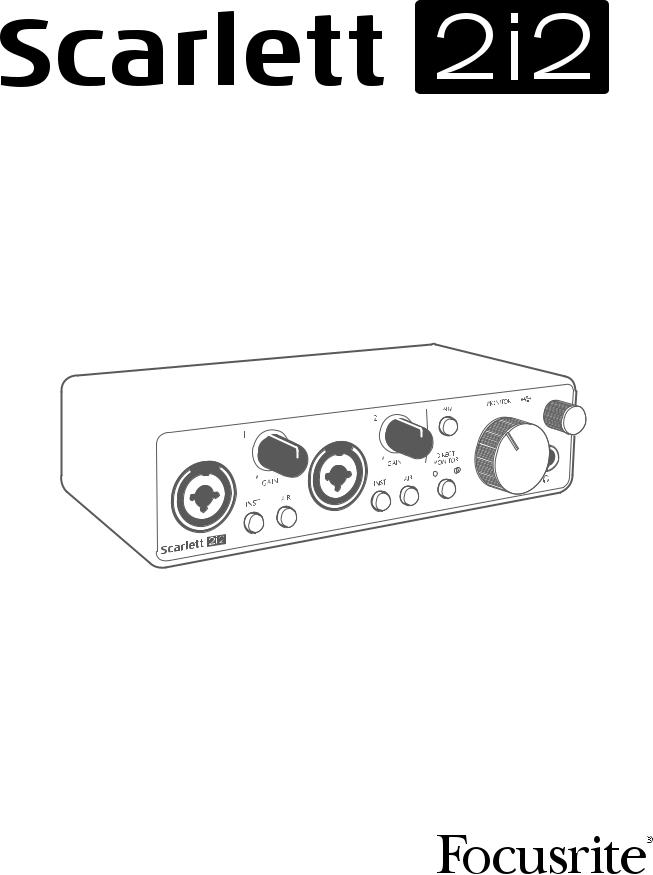
Руководство пользователя
www.focusrite.com
Версия 1.0
СОДЕРЖАНИЕ
СОДЕРЖАНИЕ . . . . . . . . . . . . . . . . . . . . . . . . . . . . . . . . . . . . . . . . . . . . . . . . . . . . . . . . . . . . . . . . . 2
ОБЗОР . . . . . . . . . . . . . . . . . . . . . . . . . . . . . . . . . . . . . . . . . . . . . . . . . . . . . . . . . . . . . . . . . . . . . . . . 3
Введение . . . . . . . . . . . . . . . . . . . . . . . . . . . . . . . . . 3 Особенности . . . . . . . . . . . . . . . . . . . . . . . . . . . . . . . . 3 Комплект поставки . . . . . . . . . . . . . . . . . . . . . . . . . . . . . 4 Требования к системе . . . . . . . . . . . . . . . . . . . . . . . . . . . . 4
|
НАЧАЛО РАБОТЫ . . . . . . . . . . . . . . . |
. . . . . . . . . . . . . . . . . . . . |
. . . . . |
. . . . . |
.5. . . . . . . . . . . |
|
Средство быстрого запуска . . . . . |
. . . . . . . . . . . . . . |
. . . |
. . . |
. 5 |
Только для пользователей Mac . . . . . . . . . . . . . . . . . . . . . . . . . 5 Только для пользователей ОС Windows . . . . . . . . . . . . . . . . . . . . . . 7 Для всех пользователей . . . . . . . . . . . . . . . . . . . . . . . . . . . . 9 Ручная регистрация . . . . . . . . . . . . . . . . . . . . . . . . . . . . . . 9
|
Настройка аудиоканала в приложении DAW . . . . . . . |
. . . . . . . |
. . . . 10 |
|||||
|
Примеры применения . . . . . . . . . . . . . . . . . . . . . . . |
. . . . 12 |
||||||
|
Подключение микрофона или инструмента . . . . . . . . . . . . . . . . . . . . 12 |
|||||||
|
Использование функции прямого мониторинга . . . . . . |
. . . . . . |
. |
. |
. |
. |
. |
. 13 |
|
Подключение Scarlett 2i2 к громкоговорителям . . . . . . |
. . . . . . |
. |
. |
. |
. |
. |
. 14 |
АППАРАТНЫЕ СРЕДСТВА . . . . . . . . . . . . . . . . . . . . . . . . . . . . . . . . . . . . . . . . . . . . . 16. . . . . . . . .
Передняя панель . . . . . . . . . . . . . . . . . . . . . . . . . . . . . . 16 Задняя панель . . . . . . . . . . . . . . . . . . . . . . . . . . . . . . . 17
ТЕХНИЧЕСКИЕ ХАРАКТЕРИСТИКИ . . . . . . . . . . . . . . . . . . . . . . . . . . . . . . . . . . . . . . . . . . . . . . 18
Эксплуатационные характеристики . . . . . . . . . . . . . . . . . . . . . . 18
|
Физические и электрические характеристики . . . . . . . . . |
. . . . . . . |
. 19 |
|
ПОИСК И УСТРАНЕНИЕ НЕИСПРАВНОСТЕЙ . . . . . . . . . . . . . . . |
. . . . . . . . . . |
. .20. . . . . . . . . . . |
|
УВЕДОМЛЕНИЕ ОБ АВТОРСКОМ ПРАВЕ И ПРАВОВАЯ ИНФОРМАЦИЯ |
. . . . . . . . . . . . . . |
. . 20 |
2
ОБЗОР
Введение
Благодарим за приобретение данного аудиоинтерфейса Scarlett 2i2 третьего поколения, который представляет семейство профессиональных компьютерных аудиоинтерфейсов Focusrite с высококачественными аналоговыми предусилителями Focusrite. Пользователь получает простое компактное решение для передачи высококачественных звуковых сигналов в компьютер и из компьютера, а также возможность загружать новые увлекательные программные плагины после регистрации продукта.
При разработке интерфейсов Scarlett третьего поколения мы внесли дополнительные улучшения как в характеристики, так и в функции. Благодаря улучшению параметров звукового тракта устройства в целом удалось расширить динамический диапазон и еще больше уменьшить искажения и уровень шума, а микрофонный предусилитель теперь позволяет подавать на входы сигналы более высокого уровня. Важным элементом модернизации является добавление функции Focusrite AIR. Функция AIR, включаемая для каждого канала в отдельности, незначительно изменяет частотную характеристику предусилителя, имитируя акустические характеристики наших традиционных трансформаторных микрофонных предусилителей ISA. При этом во время записи с использованием высококачественных микрофонов отмечается повышение чистоты и четкости звука в значимом диапазоне средних и высоких частот именно тогда, когда это необходимо для передачи звука вокала и многих акустических музыкальных инструментов. Также мы усовершенствовали функцию прямого мониторинга (Direct Monitor), которая встречается на предыдущих моделях Scarlett: теперь можно прослушивать записи без задержки как в монофоническом, так и в стереофоническом режиме. Аудиоинтерфейсы Scarlett третьего поколения аппаратно совместимы с операционной системой macOS, то есть они являются автоматически подключаемыми, и пользователям компьютеров Mac не нужно устанавливать специальный драйвер.
В настоящем руководстве пользователя приводится подробное описание аппаратуры, помогающее получить полное представление об особенностях эксплуатации изделия. Мы рекомендуем внимательно изучить данное руководство как тем пользователям, которые только начинают осваивать компьютерную запись, так и более опытным пользователям, чтобы узнать обо всех возможностях, которые предоставляют Scarlett 2i2 и сопровождающее программное обеспечение. Если в разделах этого руководства пользователя нет необходимой информации, обязательно посетите веб-сайт https://support.focusrite.com/, где содержится обширный список ответов на типичные запросы в службу технической поддержки.
Особенности
Аппаратный интерфейс Scarlett 2i2 обеспечивает подключение микрофонов, музыкальных инструментов либо каналов аудиосигналов линейного уровня к компьютеру, работающему под управлением Mac OS или Windows. Сигналы, подаваемые на физические входы, могут быть направлены в программное обеспечение аудиозаписи / цифровую звуковую рабочую станцию (именуемую в настоящем руководстве пользователя как DAW) с разрешающей способностью до 24 разрядов и частотой дискретизации до 192 кГц; точно так же сигналы монитора DAW или записанные выходные сигналы подаются на физические выходы устройства.
Физические выходы допускается подключать к усилителям и громкоговорителям, мониторам с автономным питанием, наушникам, аналоговому микшеру и любой другой аналоговой аудиоаппаратуре, которую требуется использовать.
3
Комплект поставки
Вкомплект поставки Scarlett 2i2 входят:
•USB-кабель «тип A – тип C»;
•информация по началу работы (отпечатана с внутренней стороны крышки коробки);
•важная информация по технике безопасности.
Требования к системе
Простейшим способом проверки совместимости операционной системы (ОС) компьютера с устройством Scarlett 2i2 является использование сетевого сервиса OS Checker на вебсайте https://customer.focusrite.com/downloads/os. По мере появления с течением времени новых версий ОС следует обращаться в наш справочный центр (Help Centre) по адресу https://support.focusrite.com/hc/en-gb, где можно найти актуальную информацию о совместимости.
4

НАЧАЛО РАБОТЫ
С третьим поколением интерфейсов Scarlett представлен новый более быстрый способ начала работы с использованием средства быстрого запуска Scarlett. Требуется лишь подключить устройство Scarlett 2i2 к своему компьютеру. После подключения устройство опознается ПК или компьютером Mac, после чего средство быстрого запуска помогает пройти все этапы процесса.
ВАЖНАЯ ИНФОРМАЦИЯ! Устройство Scarlett 2i2 имеет один порт USB 2.0 типа C (на задней панели): его подключают к компьютеру с помощью USB-кабеля из комплекта поставки. Учтите, что Scarlett 2i2 является устройством с интерфейсом USB 2.0, поэтому для установления USB-соединения требуется наличие на компьютере порта с поддержкой стандарта USB 2.0+.
Scarlett 2i2 получает питание от компьютера через USB-соединение, поэтому необходимости в отдельном источнике питания нет. Однако при использовании устройства с ноутбуком рекомендуется, чтобы ноутбук был подключен к сети питания с помощью адаптера переменного тока, так как в противном случае, при автономном питании ноутбука, аккумуляторная батарея будет разряжаться быстрее.
Первоначально компьютер распознает Scarlett как запоминающее устройство (ЗУ), и при первом подключении Scarlett переводится в режим ЗУ (MSD Mode).
Средство быстрого запуска
Мы постарались максимально упростить процесс регистрации Scarlett 2i2. Возможно, данный процесс будет понятен без разъяснений, однако ниже мы рассмотрели все шаги, чтобы показать, как это происходит на ПК и компьютерах Mac.
Только для пользователей Mac
При подключении устройства Scarlett 2i2 к компьютеру Mac на рабочем столе появляется значок Scarlett.
5

Дважды щелкните этот значок, чтобы открыть окно Finder, которое показано ниже.
Дважды щелкните значок «Click Here to Get Started.url» (Щелкните для начала работы). Это приведет к переходу на веб-сайт Focusrite, где мы рекомендуем зарегистрировать устройство.
Щелкните «Let’s get you started» (Начать регистрацию). В результате откроется форма, которая будет частично заполнена автоматически. При отправке формы будут предложены два варианта действий: перейти непосредственно в раздел загрузки, чтобы загрузить программное обеспечение для устройства Scarlett, или шаг за шагом выполнить указания по настройке исходя из собственных предпочтений. После установки программного обеспечения Focusrite Control для выполнения настройки и задания конфигурации интерфейса устройство Scarlett выйдет из режима ЗУ и больше не будет распознаваться как запоминающее устройство при подключении к компьютеру.
ОС компьютера должна автоматически переключить заданные по умолчанию аудиовходы и
аудиовыходы компьютера на устройство Scarlett 2i2. Чтобы подтвердить это, перейдите в раздел System Preferences > Sound (Параметры системы > Звук) и убедитесь, что входы и выходы
настроены на Scarlett 2i2. Чтобы получить более подробную информацию о вариантах настройки на компьютере Mac, откройте Applications > Utilities > Audio MIDI Setup
(Приложения > Утилиты > Настройка Audio MIDI).
6

PDF инструкция · 22 страниц(ы) английский
инструкцияFocusrite 4i4

User Guide
www.focusrite.com
Version 1.0
Посмотреть инструкция для Focusrite 4i4 бесплатно. Руководство относится к категории Без категории, 2 человек(а) дали ему среднюю оценку 9.1. Руководство доступно на следующих языках: английский. У вас есть вопрос о Focusrite 4i4 или вам нужна помощь? Задайте свой вопрос здесь
Главная
| Focusrite | |
| 4i4 | SCARLETT 4I4 3RD GENERATION | |
| Без категории | |
| 0815301005186 | |
| английский | |
| Руководство пользователя (PDF) |
Свойства
| Формат | Настольный |
| Вход аудио | 4 |
| Выход аудио | 5 |
Порты и интерфейсы
| Интерфейс устройства | USB |
| Версия USB | 2.0 |
| Количество аналоговых входов | 4 |
| Количество аналоговых выходов | 5 |
| Входы XLR combo | 2 |
| MIDI вход | Да |
| MIDI выход | Да |
Предусилитель микрофона
| Встроенный предусилитель микрофона | Да |
| Количество предусилителей | 2 |
| Фантомное питание 48В | Да |
| Усиление предусилителя микрофона | 56 dB |
| Входной уровень предусилителя микрофона (максимальный) | 9 dBu |
| Входной импеданс предусилителя микрофона | 3000 Ω |
Энергопитание
ЦА/АЦ преобразователь
| Преобразование из цифрового в аналоговый | 24-разрядный/192кГц |
| Поддерживаемый частоты семплирования | 44.1, 48, 88.2, 96, 176.4, 192 kHz |
Системные требования
| Поддерживаемые операционные системы Windows | Windows 10, Windows 7, Windows 8, Windows Vista, Windows XP |
| Поддерживаемые операционные системы Mac | Mac OS X 10.11 El Capitan, Mac OS X 10.12 Sierra, Mac OS X 10.13 High Sierra, Mac OS X 10.14 Mojave |
Вес и размеры
| Вес | 615 g |
| Ширина | 185 mm |
| Высота | 47.5 mm |
| Глубина | 119.7 mm |
Содержимое упаковки
показать больше
Не можете найти ответ на свой вопрос в руководстве? Вы можете найти ответ на свой вопрос ниже, в разделе часто задаваемых вопросов о Focusrite 4i4.
Какая высота Focusrite 4i4?
Какая ширина Focusrite 4i4?
Какая толщина Focusrite 4i4?
Инструкция Focusrite 4i4 доступно в русский?
Не нашли свой вопрос? Задайте свой вопрос здесь


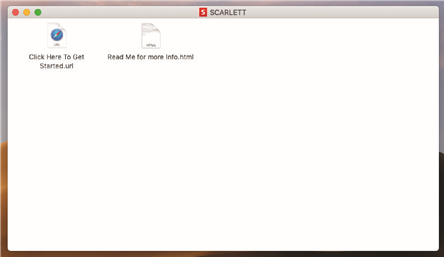
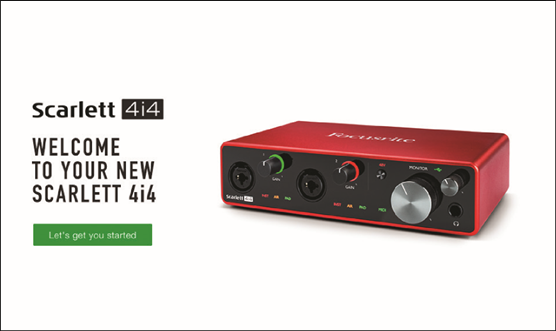

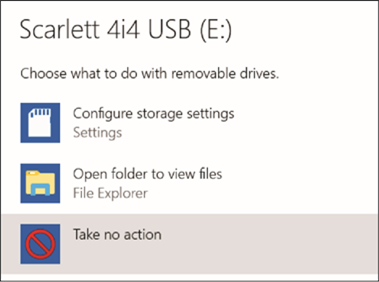
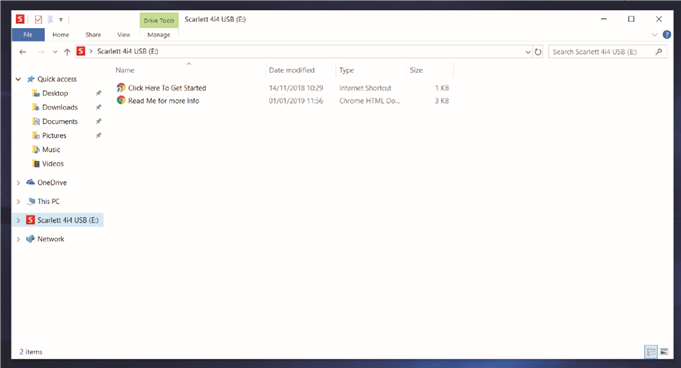
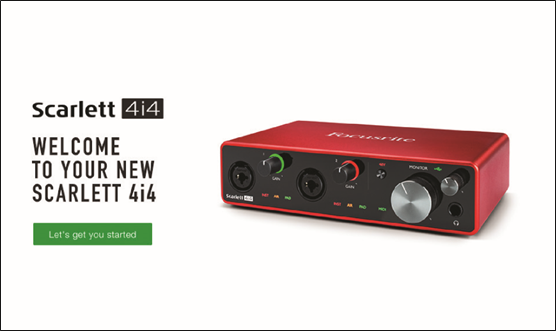
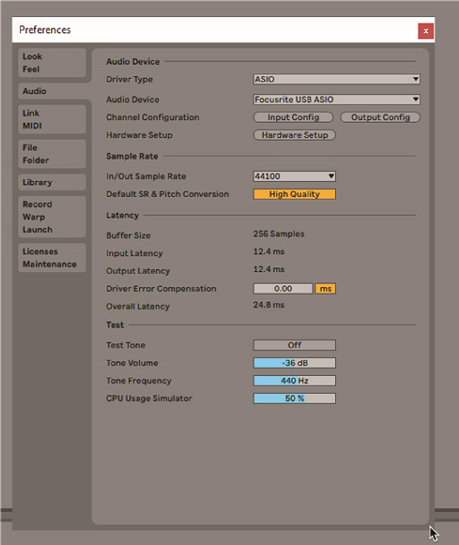
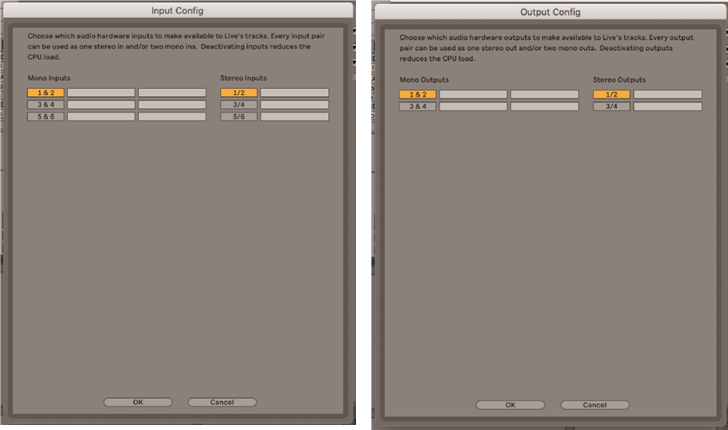
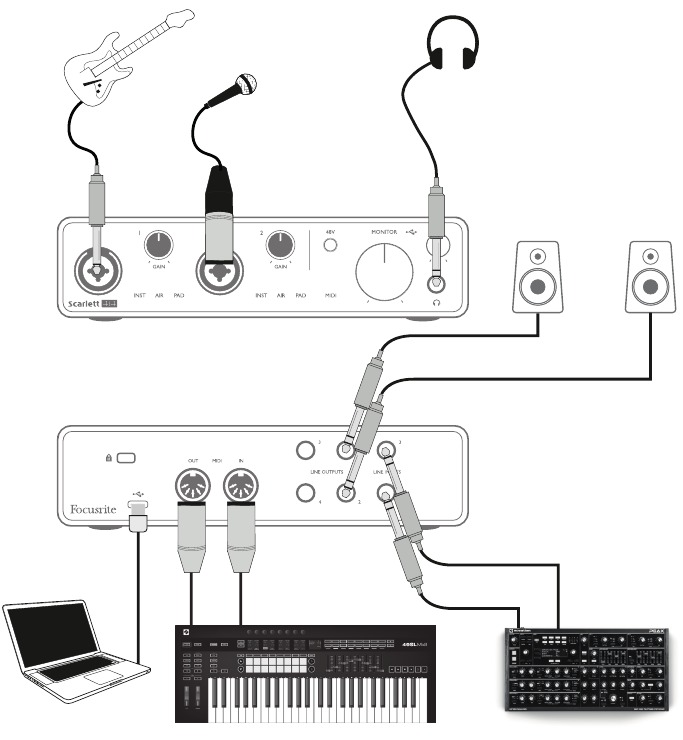

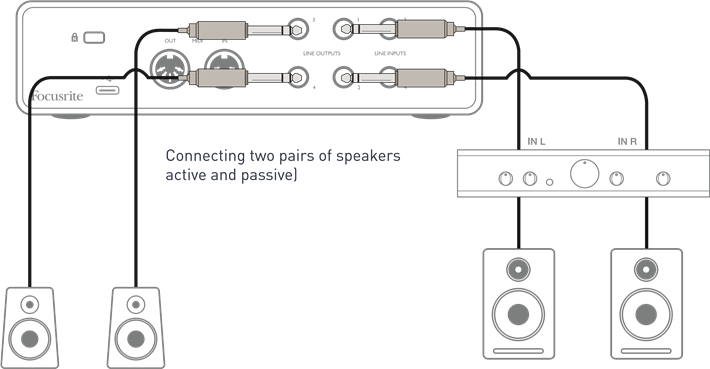
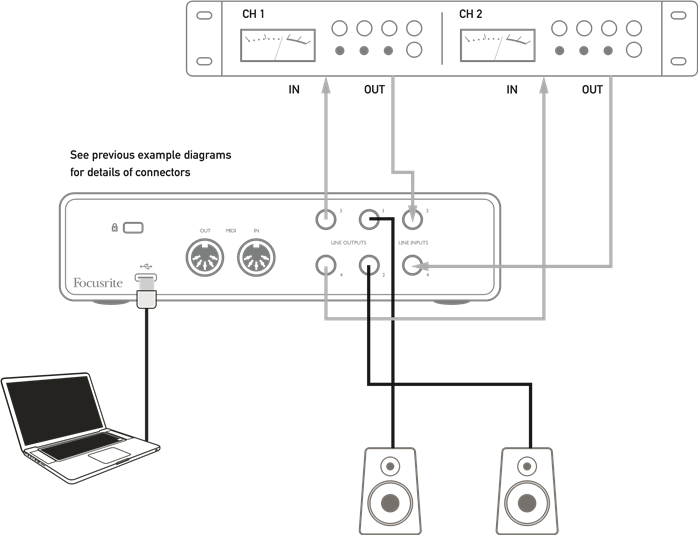
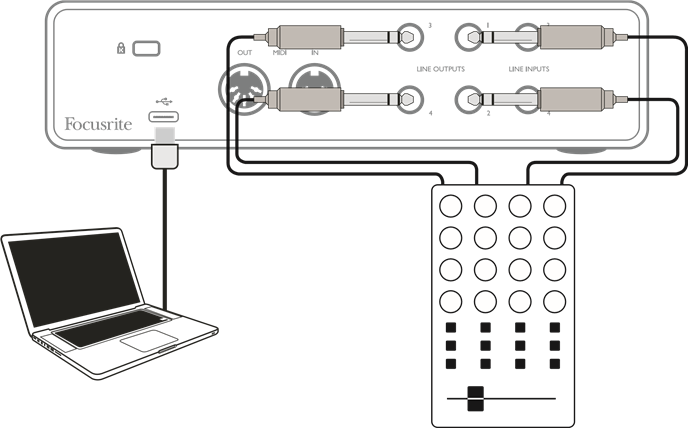
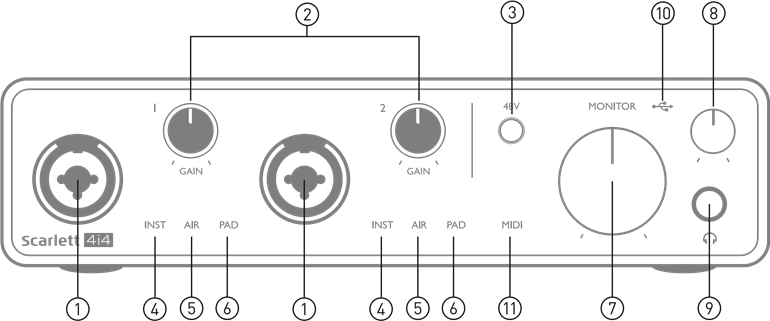
 Headphone level – adjusts the output level at the front panel stereo headphone output.
Headphone level – adjusts the output level at the front panel stereo headphone output. USB LED – illuminates when the unit receives USB bus power and is confirmed by the computer as connected and operating correctly.
USB LED – illuminates when the unit receives USB bus power and is confirmed by the computer as connected and operating correctly.